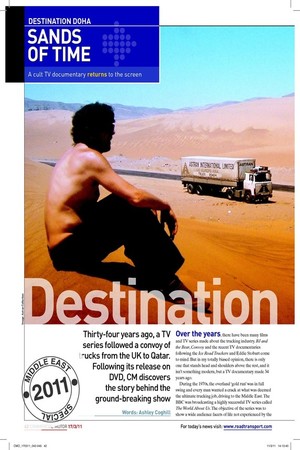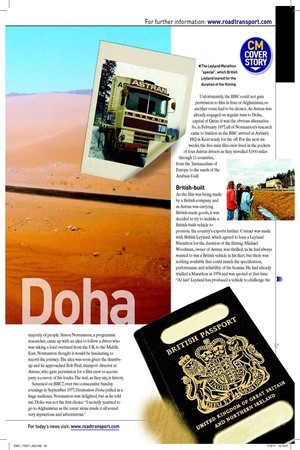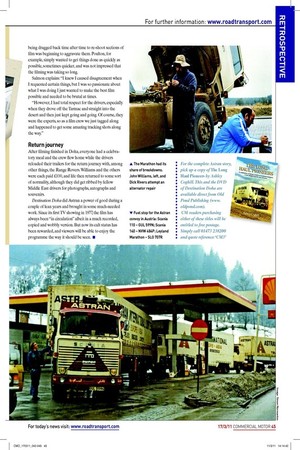estination oha
Page 31

Page 32

Page 33

Page 34

If you've noticed an error in this article please click here to report it so we can fix it.
Thirty-four years ago, a TV series followed a convoy of trucks from the UK to Qatar. Following its release on DVD, CM discovers the story behind the ground-breaking show
Words: Ashley Coghill
Over the years, there have been many films and TV series made about the trucking industry. BJ and the Bear, Convoy and the recent TV documentaries following the Ice Road Truckers and Eddie Stobart come to mind. But in my totally biased opinion, there is only one that stands head and shoulders above the rest, and it isn’t something modern, but a TV documentary made 34 years ago.
During the 1970s, the overland ‘gold run’ was in full swing and every man wanted a crack at what was deemed the ultimate trucking job, driving to the Middle East. The BBC was broadcasting a highly successful TV series called The World About Us. The objective of the series was to show a wide audience facets of life not experienced by the majority of people. Simon Normanton, a programme researcher, came up with an idea to follow a driver who was taking a load overland from the UK to the Middle East. Normanton thought it would be fascinating to record the journey. The idea was soon given the thumbsup and he approached Bob Paul, transport director at Astran, who gave permission for a film crew to accompany a convoy of his trucks. The rest, as they say, is history.
Screened on BBC2 over two consecutive Sunday evenings in September 1977, Destination Doha pulled in a huge audience. Normanton was delighted, but as he told me, Doha was not the first choice: “I secretly yearned to go to Afghanistan as the name alone made it all sound very mysterious and adventurous.” Unfortunately, the BBC could not gain permission to film in Iran or Afghanistan, so another route had to be chosen. As Astran was already engaged on regular runs to Doha, capital of Qatar, it was the obvious alternative. So, in February 1977, all of Normanton’s research came to fruition as the BBC arrived at Astran’s HQ in Kent ready for the off. For the next six weeks, the five-man film crew lived in the pockets of four Astran drivers as they travelled 5,000 miles through 11 countries, from the Tarmacadam of Europe to the sands of the Arabian Gulf.
British-built
As the film was being made by a British company and as Astran was carrying British-made goods, it was decided to try to include a British-built vehicle to promote the country’s exports further. Contact was made with British Leyland, which agreed to loan a Leyland Marathon for the duration of the filming. Michael Woodman, owner of Astran, was thrilled, as he had always wanted to run a British vehicle in his fleet, but there was nothing available that could match the specification, performance and reliability of his Scanias. He had already trialled a Marathon in 1974 and was quoted at that time: “At last! Leyland has produced a vehicle to challenge the continentals. I sincerely hope the Marathon can stand up to our work.” The film crew used two Range Rovers, packed with their equipment and supplies, to follow and film the trucks, but there was also a third car, packed with spares and supplies specifically for the Marathon, just in case it had problems. Ironically, as filming started, the convoy had only made it across the channel and into Belgium when one of the Scanias broke down.
Introducing the drivers
The drivers were introduced to the viewers from the outset. John Williams was an excellent driver and an exceptional mechanic. He had great knowledge of all the routes and was a natural leader, so he was put in charge of the convoy. Williams also had to locate and repair another Astran truck that had been abandoned in Saudi Arabia, so he was sharing his cab on the journey with Frank Hook, who would continue to drive onto Doha once Williams had departed. Next was Dave Poulton, another very experienced driver, but a quiet, modest man, who preferred to stay in his cab at night reading a good book, rather than socialise in the bars. Last, there was Dick Rivers, who was employed by British Leyland to pilot the Marathon. All in all, the men got on well throughout the journey, but there were times when friction occurred and film producer Tony Salmon had to wade in to prevent things “boiling over” .
The drivers all had their own way of doing things and being dragged back time after time to re-shoot sections of film was beginning to aggravate them. Poulton, for example, simply wanted to get things done as quickly as possible, sometimes quicker, and was not impressed that the filming was taking so long.
Salmon explains: “I knew I caused disagreement when I requested certain things, but I was so passionate about what I was doing I just wanted to make the best film possible and needed to be brutal at times.
“However, I had total respect for the drivers, especially when they drove off the Tarmac and straight into the desert and then just kept going and going. Of course, they were the experts, so as a film crew we just tagged along and happened to get some amazing tracking shots along the way.”
Return journey
After filming finished in Doha, everyone had a celebratory meal and the crew flew home while the drivers reloaded their trailers for the return journey with, among other things, the Range Rovers. Williams and the others were each paid £100, and life then returned to some sort of normality, although they did get ribbed by fellow Middle East drivers for photographs, autographs and souvenirs.
Destination Doha did Astran a power of good during a couple of lean years and brought in some much-needed work. Since its first TV showing in 1977, the film has always been “in circulation” albeit in a much recorded, copied and wobbly version. But now its cult status has been rewarded, and viewers will be able to enjoy the programme the way it should be seen. ■


















































